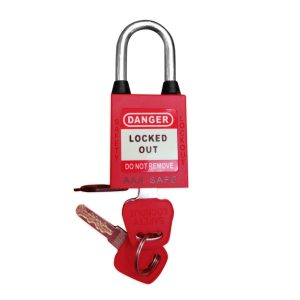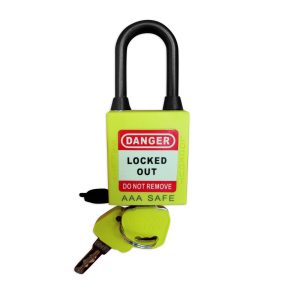In the industrial landscape of the United Arab Emirates (UAE), worker safety is of utmost importance. Among the various safety protocols, Lockout Tagout (LOTO) stands out as a critical procedure designed to protect employees from hazardous energy during maintenance and repair work on machinery and equipment. This comprehensive guide delves into ten essential aspects of LOTO, highlighting its significance and implementation within the UAE context.
1. Understanding Lockout Tagout (LOTO)
Lockout Tagout (LOTO) is a safety procedure employed to ensure that dangerous machines are properly shut off and cannot be restarted until maintenance or repair work is completed. The procedure involves isolating energy sources and securing them with locks and tags to prevent accidental activation. This is crucial for protecting workers from unexpected releases of hazardous energy that could lead to severe injuries or fatalities. By effectively isolating the energy sources, LOTO safeguards workers during maintenance activities, ensuring their well-being and preventing accidents.
2. The Importance of LOTO
The importance of LOTO cannot be overstated. It serves as a critical safeguard against the unexpected startup of machinery, which can result in severe injuries or even fatalities. By implementing LOTO, businesses ensure that machines remain inoperative while maintenance or servicing is performed, thereby protecting workers from potential dangers. Adopting LOTO procedures helps significantly reduce the risk of accidents, enhances overall workplace safety, and ensures compliance with safety regulations. For industries in the UAE, adhering to LOTO practices is essential for maintaining a safe working environment and fulfilling regulatory requirements.
3. Types of Hazardous Energy
LOTO procedures are designed to control various types of hazardous energy, each presenting unique risks. These include:
- Electrical Energy: Power sources that can cause electric shock or arc flash.
- Mechanical Energy: Moving parts that can lead to crushing or amputation injuries.
- Hydraulic Energy: Pressurized fluids that can cause sudden movement or ejection.
- Pneumatic Energy: Compressed air that can result in high-speed projectile hazards.
- Chemical Energy: Hazardous chemicals that can cause burns or respiratory issues.
- Thermal Energy: Extreme temperatures that can lead to burns or heat-related illnesses.
Understanding these types of hazardous energy is crucial for implementing effective LOTO procedures. Proper identification and control of these energy sources are essential to ensuring the safety of workers during maintenance and repair tasks.
4. Key Components of a LOTO Program
A comprehensive LOTO program includes several key components to ensure its effectiveness:
- Energy Control Procedures: Detailed steps outlining how to shut down, isolate, and secure machinery. These procedures should be documented and readily accessible to all relevant personnel.
- Employee Training: Ensuring that all employees understand the purpose of LOTO and are trained in its procedures. Training should cover how to apply and remove locks and tags, as well as how to respond in case of emergencies.
- Periodic Inspections: Regular audits and inspections to ensure compliance with LOTO procedures and to assess the effectiveness of the program. These inspections help identify any gaps or areas for improvement.
By incorporating these components, businesses can establish a robust LOTO program that effectively controls hazardous energy and promotes a culture of safety.
5. Roles and Responsibilities
In a LOTO program, clear roles and responsibilities are essential for proper implementation:
- Authorized Employees: These individuals are specifically trained to perform LOTO procedures and service equipment. They are responsible for applying and removing locks and tags, as well as ensuring that the machinery is properly shut down and isolated.
- Affected Employees: Workers who operate or use machinery that is being serviced. They need to be informed about the maintenance work and LOTO procedures to understand the potential impact on their tasks.
- Other Employees: Individuals who work in areas where LOTO procedures are being implemented. They should be aware of the LOTO activities and take necessary precautions to avoid any interference with the process.
Clearly defining these roles ensures that all employees are aware of their responsibilities and contributes to the overall success of the LOTO program.
6. Steps for Implementing LOTO
Implementing LOTO involves several critical steps to ensure its effectiveness:
- Notify Employees: Inform all affected employees about the upcoming maintenance work and the LOTO procedures that will be applied. Clear communication helps ensure that everyone is aware of the potential hazards and the actions being taken to mitigate them.
- Prepare for Shutdown: Identify the energy sources connected to the equipment and prepare it for shutdown. This involves assessing the equipment and determining the appropriate methods for isolating the energy sources.
- Isolate Equipment: Disconnect the equipment from all energy sources, including electrical, mechanical, hydraulic, and pneumatic sources. Proper isolation prevents the equipment from being inadvertently re-energized.
- Apply Lockout/Tagout Devices: Secure the energy isolation devices with locks and tags to indicate that the equipment is being serviced and should not be operated. These devices serve as a visual and physical barrier to prevent accidental activation.
- Release Stored Energy: Ensure that all stored energy, such as compressed air or hydraulic pressure, is safely released. This step is crucial for preventing unexpected energy releases that could pose risks to workers.
- Verify Isolation: Confirm that the equipment is completely isolated and inoperative. This involves testing the equipment to ensure that it cannot be started or re-energized before maintenance work begins.
By following these steps, businesses can effectively implement LOTO procedures and enhance worker safety during maintenance activities.
7. Legal Compliance in the UAE
In the UAE, compliance with safety regulations is mandatory for all industrial operations. LOTO procedures play a vital role in adhering to these regulations, helping businesses avoid legal penalties and demonstrate a commitment to worker safety. The UAE’s regulatory bodies mandate the implementation of safety measures like LOTO to protect employees from hazardous energy. Ensuring that LOTO procedures are in place and followed can help businesses meet regulatory requirements and foster a culture of safety within the workplace.
8. Challenges in LOTO Implementation
Despite its importance, implementing LOTO can present several challenges, including:
- Inadequate Training: Insufficient training can lead to misunderstandings or improper application of LOTO procedures. Ensuring that all employees receive comprehensive training is essential for overcoming this challenge.
- Poor Communication: Effective communication among employees is crucial for successful LOTO implementation. Poor communication can result in confusion and non-compliance with safety procedures.
- Outdated Practices: Outdated or inadequate LOTO practices can hinder the effectiveness of the program. Regular reviews and updates are necessary to address this issue and ensure that LOTO procedures remain relevant and effective.
Overcoming these challenges requires a commitment to continuous improvement, regular training, and effective communication among all employees involved in LOTO procedures.
9. Benefits of Effective LOTO Implementation
Implementing LOTO effectively offers numerous benefits, including:
- Enhanced Safety: Reduces the risk of accidents and injuries by controlling hazardous energy during maintenance activities.
- Compliance: Ensures adherence to safety regulations and helps avoid legal penalties.
- Increased Productivity: Minimizes downtime and operational disruptions by preventing unexpected machinery startups and related accidents.
- Cost Savings: Reduces expenses related to accidents, equipment damage, and associated insurance claims.
By reaping these benefits, businesses can create a safer working environment, improve productivity, and achieve cost savings.
10. Continuous Improvement and Training
To maintain an effective LOTO program, continuous improvement and regular training are essential. Training should cover:
- Identification of Energy Sources: Ensuring that employees can accurately identify and assess hazardous energy sources.
- Proper Use of LOTO Devices: Educating employees on how to correctly use locks and tags to secure energy sources.
- Emergency Response Procedures: Preparing employees to respond effectively in case of emergencies related to LOTO.
Regular audits and updates to the LOTO program help ensure that it remains effective and compliant with evolving safety standards. By fostering a culture of continuous improvement, businesses can ensure that their LOTO programs are always up to date and capable of safeguarding workers.
Conclusion
In the UAE’s industrial sector, where safety is a top priority, understanding and implementing Lockout Tagout (LOTO) is crucial. By effectively controlling hazardous energy during maintenance and repair work, LOTO protects workers, enhances safety, and ensures compliance with regulations. Businesses that prioritize LOTO can reduce the risk of accidents, improve productivity, and foster a culture of safety. Through continuous training and improvement, companies can ensure that their LOTO programs remain effective and aligned with best practices, ultimately contributing to a safer and more productive work environment.

















